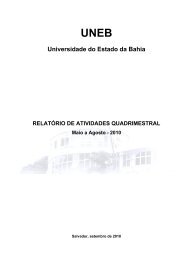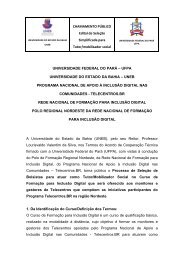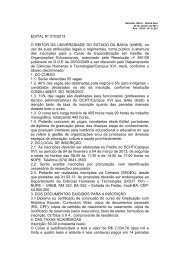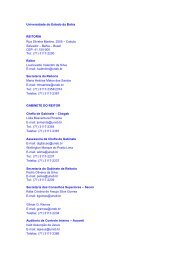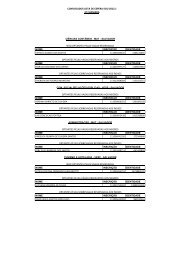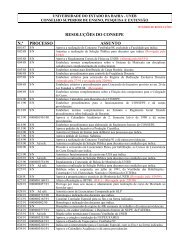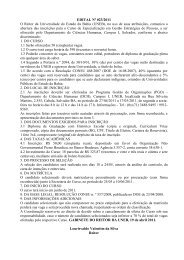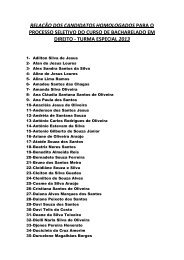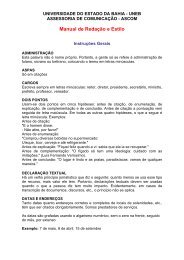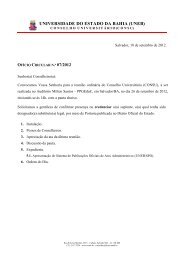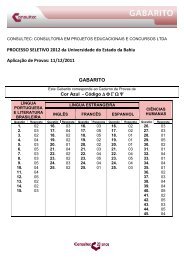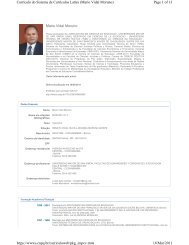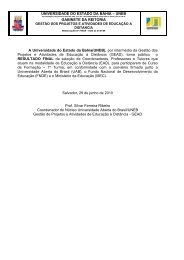Revista da FAEEBA Educação e Contemporaneidade - Uneb
Revista da FAEEBA Educação e Contemporaneidade - Uneb
Revista da FAEEBA Educação e Contemporaneidade - Uneb
Create successful ePaper yourself
Turn your PDF publications into a flip-book with our unique Google optimized e-Paper software.
In search of América: latina/os (re)constructing the U.S.A.<br />
248<br />
pero tú con tus calumnias,<br />
me niegas tu sonrisa<br />
me siento mal, agallao<br />
yo soy tu hijo,<br />
de una migración<br />
pecado forzado,<br />
me man<strong>da</strong>ste a nacer nativo en otras tierras<br />
por qué, porque éramos pobres, ¿ver<strong>da</strong>d?<br />
Porque tu querías vaciarte de tu gente pobre,<br />
Ahora regreso, con un corazón boricua, y tú,<br />
Me desprecias, me miras mal, me atacas mi hablar,<br />
Mientras comes mcdonalds en discotecas<br />
americanas,<br />
Y no pude bailarla salsa en san juan, la que yo<br />
Bailo en mis barrios llenos de to<strong>da</strong>s tus<br />
costumbres,<br />
así que, si tú no me quieres, pues yo tengo<br />
un puerto rico sabrosísimo en que buscar refugio<br />
en nueva york, y en muchos otros callejones<br />
que honran tu presencia, preservando todos<br />
tus valores, así que,por favor, no me<br />
hagas sufrir, ¿sabes? (LAVIERA, 1985, p.53)<br />
The differing experiences and perceptions<br />
of mainland and Island Puerto Ricans could not<br />
have been more apparent than in their response<br />
to Mattel’s release of “Puerto Rican Barbie”<br />
in 1997. Puerto Ricans on the Island were<br />
delighted; Puerto Rican Barbie was an affirmation<br />
of their existence. Mainland Puerto Ricans,<br />
on the other hand, were offended by her<br />
light skin, Anglicized features, and colonial-tiered<br />
dress. The divergent views were prominently<br />
displayed in Island and mainland Puerto Rican<br />
news coverage.<br />
Evidently both communities wrapped a different<br />
narrative around the plastic and made the Barbie<br />
a desirable playmate – silent, but endowed – to<br />
engage in the increasingly high-stakes game of<br />
interests and intrigue called ‘Puerto Rican identity.’<br />
(NEGRÓN-MUNTANER, 2002, p.39)<br />
Puerto Ricans’ disruption of racial categories<br />
in this instance – and so many others—<br />
speaks to the emergence of new ways of being<br />
“Puerto Rican” on the mainland. Like Chicanos’<br />
insistence on defining who they are, it also<br />
reveals the socially constructed nature of racial<br />
categories, providing yet another rent in<br />
the fabric of American binary constructions<br />
of race.<br />
From Melting Pot to Tapestry?<br />
Latina/os have been major contributors to a<br />
seismic shift in the U.S., from celebrating the<br />
nation as a homogeneous melting pot to conceptualizing<br />
and (at least in name) valuing it as culturally<br />
pluralistic, a “tapestry” or a “salad” made<br />
up of diverse and distinctive ingredients that taken<br />
together comprise a whole, with all contributing<br />
to the “mix.” U.S. history and literature texts in<br />
schools to<strong>da</strong>y are more “multicultural” and sensitive<br />
to cultural stereotyping than texts in the<br />
1960s (REINHOLD, 1991). More accurate and<br />
balanced treatments of Mexican-U.S. relations<br />
may still all too infrequently make their way into<br />
high school U.S. history texts (ROSALDO and<br />
FLORES, 1997), but there has been movement.<br />
Schools can no longer punish students for speaking<br />
Spanish on school grounds, as happened<br />
into the 1960s (CRAWFORD, 1995). Schools<br />
are now required to provide students assistance<br />
learning English since the 1973 Supreme Court<br />
case Lau vs. Nichols. Teachers in training are<br />
required to complete coursework on multicultural<br />
education. By 1997, the renowned American<br />
historian Nathan Glazer, who had earlier characterized<br />
the calls for affirming cultural pluralism<br />
and the emphasis on the oppression<br />
experienced by minority groups as divisive, epitomized<br />
the shift by proclaiming in print that “we<br />
are all multiculturalists now.”<br />
Backlash<br />
The transition has not been a smooth and<br />
unidirectional one. The profound critique launched<br />
by people of color, women, social historians,<br />
and other academics and activists<br />
confronted a sustained counterattack beginning<br />
in the 1980s. It is a culture war that continues<br />
to the present <strong>da</strong>y.<br />
In my own ethnographic research in upstate<br />
New York in the early 1990s 19 , in which I examined<br />
community and school discourses regar-<br />
19 See American Conversations (BIGLER, 1999) for a fuller<br />
treatment of the community conflict over multiculturalism<br />
and bilingualism.<br />
<strong>Revista</strong> <strong>da</strong> <strong>FAEEBA</strong> – <strong>Educação</strong> e Contemporanei<strong>da</strong>de, Salvador, v. 15, n. 25, p. 239-257, jan./jun., 2006



